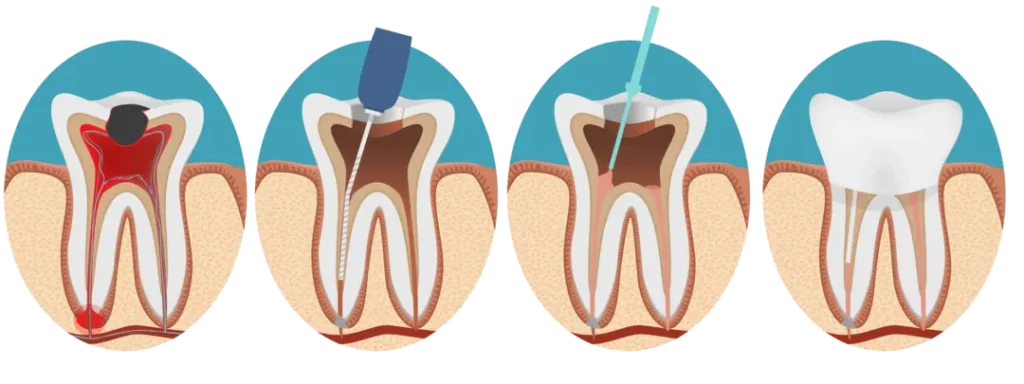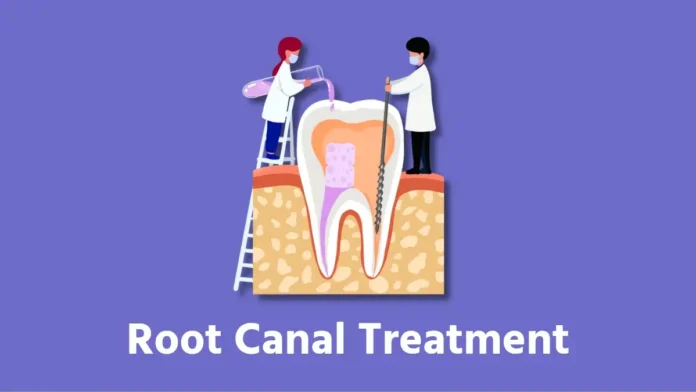Root canal treatment is advised by dentists to save your infected tooth due to infection of the tooth pulp.
Root canal treatment is designed to remove infected pulp, eliminate bacteria, and infected material or pus from the infected root canal, prevent reinfection of the tooth, and save the natural tooth. The term root canal comes from the cleaning of the canals inside the tooth’s root.
What happens during Root Canal Treatment?
Are you worried that your dentist or Endodontist advised you about the root canal procedure to treat your damaged or diseased tooth? Don’t worry. Millions of teeth are treated and saved this way each year, relieving pain and making teeth healthy again.
There are mainly three layers of teeth, the top most enamel (hardest layer), then dentin, and the most inside, soft pulp tissue. That contains nerves, blood supply, and connective tissue that provides nutrition to your tooth and helps to grow the root of your teeth during teeth development.
Now, when caries or tooth decay is involved in the third layer of the tooth (dental pulp) or it may be damaged or infected by bacteria, allowing bacteria to multiply and spread rapidly, then we require Root canal treatment.

A modern root canal treatment is nothing like those old sayings! It’s very similar to a routine filling and can usually be completed in one or two appointments, depending on the condition of your tooth and your circumstances. Getting a root canal is relatively painless and extremely effective. You’ll be back with a smile.
Signs and Symptoms
In the following cases, you may require Root Canal Therapy.
1. Tooth pain : Toothache is a common dental problem a patient complains of, If you have continuous pain in your tooth then it is advised to consult a dentist as you may require RCT. If you feel pain while eating or touching your tooth, it may be a sign that the nerves in the pulp are damaged.
2. Teeth Sensitivity : Sensitivity could be the potential symptom. You may feel sensitivity while eating sweet, hot, and cold food.
3. Swollen tender Gums : Because of infection in the tooth, pus (containing bacteria and infection material) causes swollen and tender gums.
4. Discolored tooth or darken : When the pulp of the tooth becomes dead, it can cause your tooth to look darker. This occurs because of poor blood supply to the tooth.
5. Facial swelling : Sometimes pus doesn’t drain or come out from the site of infection. As a result, it creates pressure on surrounding tissues and the jaw may become visibly swollen.
6. Cracked or fractured tooth : Tooth can crack or fractured due to many reasons like accidents, mistakenly eating hard substances, etc. It helps bacteria to enter deep into the tooth, causing infection.
Such a tooth is either saved through root canal treatment or removed if there’s no chance of treatment.
All these points are common in patients of Root Canal Treatment; however, without clinical and radiographic examination it can’t be confirmed.
Steps of Root Canal Treatment

Step 1 : For painless comfortable treatment, local anesthesia is administered to the affected tooth and surrounding soft tissue. So, it will be completely numb and the dentist can work.
To ensure precise isolation of the affected area, a rubber dam is used to cover your teeth.
Step 2 : After that, the dentist will open the tooth pulp chamber to get access to infected pulp and root canals. Looks scary? Don’t worry it won’t hurt.
Step 3 : Now, this infected pulp tissue inside the pulp chamber and root canals are then removed through the endodontic instruments. You won’t feel any sensation or pain after this step as all the infected pulp has been removed in this step.
Step 4 : After that, the tooth will need to be disinfected to prevent further re-infection due to exposure to the bacterial environment.
Step 5 : Next, root canals need to be shaped to allow space for root canal filling material to be applied.
Step 6 : The material used in RCT treatment is known as gutta-percha and it is inert, so it is totally safe. It is inserted in the canal with sealant material. Gutta-percha material becomes soft by heating, so it is heated to fit in your canal.
Step 7: Temporary or Permanent cement is placed as filling material, depending upon the situation, for filling the tooth. Finally, Root Canal Treatment is complete.
Make sure you take all the important care, medicines, and instructions given by your dentist.
After finishing the course of medication and permanent filling, a crown (also popular as a tooth cover) is mandatory to protect the treated tooth and prevent the fracture of the tooth.
How long does the Root Canal Treatment procedure take?
Depending on the amount of infection in your tooth, RCT may require one or two appointments.
On average it takes about 30-60 min to complete and if you are having treatment of larger teeth like molars, it may require 60-90 min.
Alternatives to Root Canal Treatment
Tooth removal is the only alternative to RCT even though it’s recommended to save natural teeth whenever possible.
After tooth extraction, you can replace your teeth with a Dental Implant, Fixed partial denture or Bridge, or removable prosthesis.
How to prevent Root Canal infection or deep cavities?
- Brushing at least twice a day.
- Floss at least once in a day.
- Wear a mouth guard to avoid sports-related injury.
- Visit a dentist regularly.
Common Myths about Root Canal Treatment among People
1. Myth : Tooth Pain = Root Canal
Fact : Toothache can be caused by tooth decay, gum disease, impacted teeth, and many other non-dental causes, like sinus pressure. Root canals are only needed when the pulp of a tooth becomes infected.
2. Myth : Root canal treatment is painful.
Fact : It’s 2023. Digital dentistry, with advanced materials and medicines, has made root canal surgery as easy as having a cavity filled, with fewer dental appointments.
3. Myth : Teeth removal is better than RCT.
Fact : Saving the natural tooth is often better than extracting it. Removing a tooth without a plan for replacing it can lead to malocclusion, affecting your bite and potentially requiring extensive treatment in the future.
4. Myth : Root canal causes illness.
Fact : This was a rumor started by Dr. Weston Price in 1910. His research claimed that endodontically treated teeth could leave patients susceptible to infection and illness.
5. Myth : It’s a Long and Involved Process.
Fact : Most root canals may be completed in one visit, while some cases require two or more visits due to infection and inflammation. It is best to speak to your dentist about any questions or concerns you have prior to treatment.

